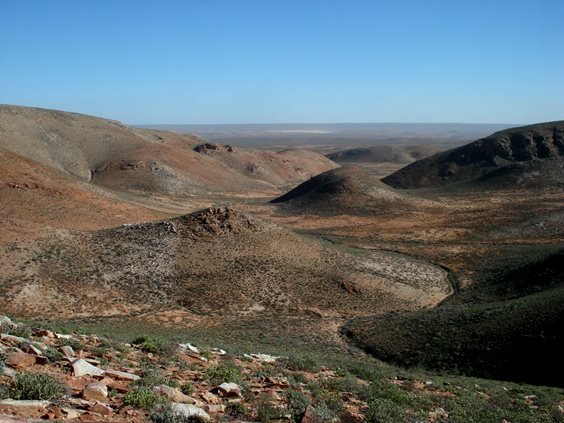A panoramic view and a long walk

Graham Williamson called the Richtersveld an enchanted wilderness in the title of his book on this part of the country and the species that inhabit it. The remote and fairly inaccessible territory, a quiet expanse in the far northwest of the country, comprises forbidding mountain slopes, peaks and gorges, as well as quartzitic, sandy desert plains.
The west coast next to the cold Benguela Current and the Gariep River next to the Namib Desert in the north constitute clear borders. Gradual integration with the rest of Namaqualand to the south and with Bushmanland to the east delineate the area. The Cornellsberg is the highest point in the Richtersveld at 1377 m, the low-lying Gariep or Orange River valley and the western Sandveld plain in contrast.
Rare flash floods and common fierce winds sculpt the features of topography over the centuries and move the sands. The west is moistened by coastal fog and there is winter rain... much spoken of although it is so little.
The geology is fascinating and diverse, including old volcanic rock and mountain peaks to nearly 2000 million years old, some displaying quartzitic sunrise glow. The orange-brown granites are less than half as old, while still younger sedimentary and more volcanic rock of the Gariep Complex, the Stinkfontein Formation where a relic fynbos vegetation is found and other eventful features abound to stimulate curiosity.
The land and its climate dictate narrow limits to what can live here. Many resilient species of plants, small animals and some birds are adapted for the life on offer, some especially of interest due to particular adaptations defining them. Diverse shy plant adaptations, including many endemic succulents, ensure that nobody becomes an expert on anything too quickly here.
Fossils abound among the rocks, telling of early plant, animal and human struggles over the ages. There are those that come here to search for them.
Indigenous people today keep free-roaming goats, often exceeding carrying capacity of the land, the owners poor. Apart from these inhabitants that hail from the Richtersveld, others arrived, lured by images of glittering minerals; yes, also diamonds. Many others are driven by a sense of adventure, or simply like to drive their specially equipped vehicles in remote places where running out of road happens all the time.
Then there are, of course, the plant and animal enthusiasts with curiosity sufficiently stirred to walk across this desolate land with eyes peeled, encumbered by cameras, water bottles, even notebooks and more.
Sparse shade on a hot day from Aloidendron pillansii (the giant quiver tree) or Pachypodium namaquanum (the halfmens, i.e. half human) may be on offer, but the next one to sit under on most routes may be reached only tomorrow (Grenier, 2019; Williamson, 2010).

